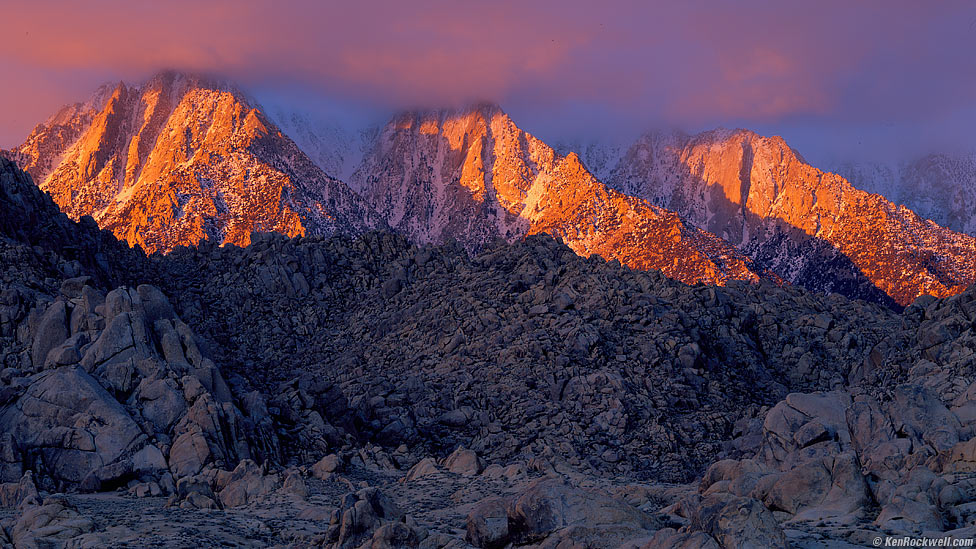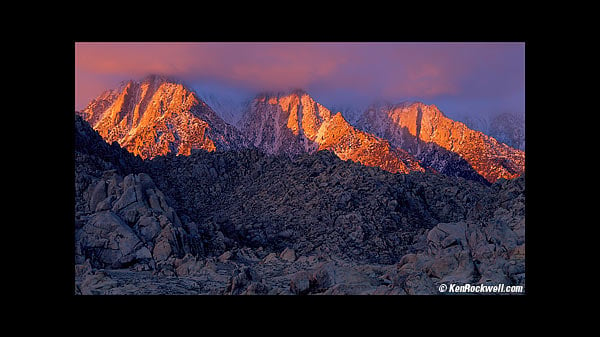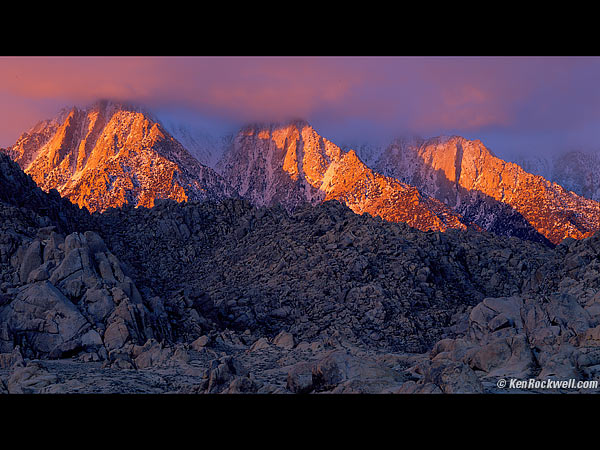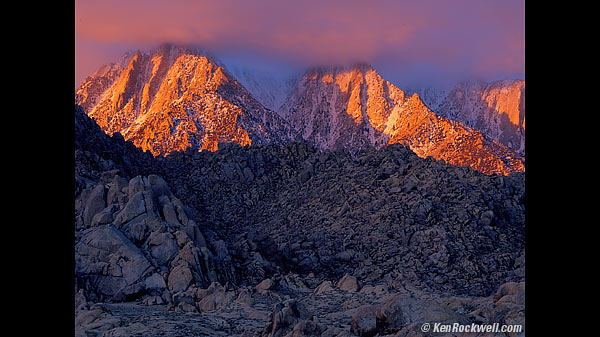Home Search Gallery How-To Books Links Workshops About Contact
Fitting the Picture For HDTV goodies, try Adorama, Amazon, B&H Photo-Video and J&R. It helps me keep adding to this site when you get yours from these links, too. Thanks! June 2008 back to HDTV index Why do you get this most of the time on your expensive HDTV:
Lone Pine Peak: What you get on HDTV. When you paid for this? |

Lone Pine Peak: What you paid for. We sent men to the moon in 1969. TV pictures always filled our screens, even if they came live from the Moon. So with forty years of advancement, how come our pictures today don't always fill our big screens? This is why I almost never waste my time with HDTV broadcasts. The TV industry still hasn't figured out how to get pictures to fit our screens. If I watch TV, I watch the standard-definition channel which usually fills the screen and looks much better. Here's why: Aspect Ratios (picture shapes)
This is the biggest problem in TV today. We now have two shapes of TV, regular and wide, so there is no way that one picture will look right on two different shaped sets. When an image of one shape is seen on a screen of a different shape, it is shrunk to fit. When it goes back to a screen of the original shape, it is shrunk again instead of properly being enlarged. The shape (width) of your screen has nothing to do with resolution. Resolution and screen shape are unrelated. Most people prefer a big, wide picture regardless of the resolution. There are plenty of wide-screen images in standard definition, like from a DVD player, which look superior to broadcast and cable HD images. SDTV Aspect RatioSDTV uses images the same standard shape that's been used since 35mm movie film came out in the 1800's: 4:3. This shape (aspect ratio) was copied by TV in the 1930s, copied again by computers in the 1970s (640x480 VGA and all standard shape computer screens today), and used today in all compact digital cameras and 4:3 system DSLRs. The 4:3 AR is also called 1.33:1. Movie Aspect RatiosMovies were 4:3 when 35mm movie film was standardized in the 1800s. The standard movie frame is, and still is, 24mm wide by 18mm tall. These frames look right when film is held with the perforations running vertically, as film runs through a movie camera or projector. 35mm still cameras, and thus FX and "full-frame" digital cameras, use two movie frames side-by-side, for 24mm x 36mm images. These look right when the film perforations run horizontally. When TV started getting popular in the early 1950s, movie makers freaked out, thinking that no one would bother paying to go to the movies when people could watch TV for free at home. Various wide and Cineramic movie formats were invented to offer movie-goers what they couldn't get at home: big, wide screens. Today, the two movie formats which survive are 1.85:1 (called "flat" in the movie biz) and 2.40:1 anamorphic (also called "scope" and 2.35:1). (see more at Panavision.) HDTV Aspect RatioBoth 720p and 1080i use wider images, called 16:9 or 1.78:1. Where did this come from, since it has nothing to do with movies or TV? Movies have been wider than HDTV since the 1950s. Back in the 1980s, engineers working in their own vacuum decided amongst themselves that the most efficient shape for a screen, which had to display 4:3 TV and 1.85:1 and 2.40:1 movies, was 16:9 (1.78:1). Why? Because TV picture tubes cost about the same based on their diagonal measurement, regardless of the shape of the rectangle or square inches of picture area. A 16:9 tube wasted the least space with black bars when you averaged all the wasted black space when showing the various formats, none of which fits a 16:9 tube. When the artists who actually make movies heard about this dopey new arbitrary "sort of best fit" 16:9 aspect ratio, Hollywood's by-invitation-only American Society of Cinematographers went crazy. They rightfully pointed out that TV finally had the chance to display movies properly, but botched it by coming up with a new, corny and completely unrelated to anything 16:9 aspect ratio. Oh well, this is what we have today, and sadly very few people are fortunate enough to be able to watch on tubes, for which 16:9 was chosen. Worse, as the ASC foretold, we now have four different aspect ratios, only one of which works properly on any given screen.
Making Movies fit TV and DVDsHollywood has never had any technical problems getting widescreen movies to fit regular TVs. We've been doing this for decades. It's done in telecine (transferring from film to video). In telecine, the colorist (telecine operator) has to crop each and every frame differently, by hand. In a very wide 2.40:1 Panavision format, often two people will talk to each other from opposite sides of the frame. In these cases, the colorist takes alternate crops. Sometimes movie buffs will notice things missing in a 4:3 transfer of a scope movie, but it's rarely a serious problem. If Hollywood has been able to do this for decades, than why the heck doesn't anything fit on HDTV? Simple: The colorist is a highly skilled artist, usually hand-picked by each director to transfer his work. Colorists made about $250,000 a year back when I worked in Hollywood. It costs about $700 an hour for telecine work, and telecine work is done offline, that is, it takes a lot more time to go thorough frame-by-frame and adjust colors and cropping than it does to just play the movie. It takes about ten hours of careful work to transfer an hour of film, or about 15 hours at $700 an hour to transfer a typical movie. That's $10,000. A TV network or premium service like HBO has no qualms about paying that for their own transfer of a feature film. The problem is that your local TV station doesn't. There's no one at the station to ensure that each and every used-car dealer ad and news clip and national ad and network feed all fit your screen. There certainly aren't two guys at your station to do two sets of adjustments, one for regular TV and another for the HDTV feed. Even if there were these guys, you can't do frame-by-frame fine-tuning fast enough for live TV. Even if they could, TV stations don't have the tools. Broadcast TV and cable are screwed, just as I warned in 1988. Black BarsDo black bars along the top and bottom (or sides) of your screen piss you off? They do me. I foretold this problem in the 1980s, and it's only getting worse.
16:9 image in a 4:3 broadcast feed.
Above image, boxed-in for 16:9 HDTV/DTV/ATSC broadcast. This is what you get over-the-air on your 16:9 big screen when an HD station broadcasts from a 4:3 feed. It's lame. TV people try to blame everyone else for this. Complain to your cable company or local TV station, and they'll all point the blame somewhere else. The problem is with the people who create the content you're watching. It's not your TV, only partially the fault of the TV station, and it's not the cable company. HDTV broadcast is the worst. I'm ashamed that I wasted twenty years of my career in HDTV. We won't watch HDTV broadcasts in my home since regular channels fill our screen better. What happens is that every time a picture needs to be seen on a screen of a different shape than the picture, black bars (or "ESPN" borders) are added to make it fit. This little picture is the ultimate insult to a man who just dropped a big chunk of change on a big screen HDTV. When an image, in the course of the numerous stages through which it passes from camera to lab to telecine to editing to TV network to your local station to your cable company and finally to your home, changes from one picture shape (aspect ratio) to another cause it to grow borders (black bars) at every stage. Heaven help you that it goes back and forth between shapes on the way to your home, because it now has grown borders on all four sides! The broadcast world is too lazy to restore the image to full size when it's appropriate, so you often get this sorry crap on an HDTV. Most of the day, HD stations simply regurgitate SD programming, so all you'll get is this:
HDTV broadcasts usually look like this. Most HDTV stations rebroadcast SDTV (4:3) material most of the time, and all you get at home is an image with black on the left and right. This is garbage, especially because I know of no sets which can take this HD signal with black on both sides and stretch it out to fill the larger screen properly. All the sets I've tried simply give up when they are fed with a signal in HD format like this, regardless of the source of the picture, or offer arbitrary levels of manual zoom. This is why we watch the regular channels and not HD broadcasts at my house. HDTVs can stretch a standard-definition image to fill their screens, but can't stretch an HD picture like that above. If it's an SD signal, you're not losing anything watching the standard channel to fill your screen anyway. This is why I'm so embarrassed for the broadcast industry. I spent 20 years developing all this, and I'd still rather watch the non-HD feeds 99% of the time. I only fire up the HD channels out of my engineering curiosity. Junk "Protection" BarsBroadcast and cable HDTV are awful most of the time not just because of the black bars, just as often real screen-filling HD shows have nothing going on on the sides of your expensive flat panel set! The details and action only happen in the middle of the screen. The sides of the image are often just trees or plants. The problem is that TV networks need to produce wide-screen HDTV programming which looks OK when the sides are chopped-off automatically for normal 4:3 TV screens. The HD feed goes out to the HD stations, and the sides are simply chopped off, downconverted and fed to the standard definition stations. There are no separate feeds shot for each. Therefore, genuine HD shows have all the action, titles and statistics crowded towards the center. I'm serious: cover the left and right parts of your screen (locate them from the the burn-ins on your plasma from watching all the black or ESPN-HD borders in HDTV broadcasts) and you'll not miss any of the action or titles! All you're getting on the sides of a real HDTV show is junk, like scenery or lines from graphics that simply extend a few inches more to the sides. The only action on the sides is talent or players walking on or off the stage. We call this "shooting in 16:9 and protecting for 4:3," and it looks awful to the informed viewer. ESPN HD is a joke. The real HD shows have only junk on the sides, and the rest of the time when there isn't any wasted picture on the sides, there are blue ESPN-HD or fuzzy mirror-image borders. These aren't special effects, they are sorry mistakes! I'm not kidding: while writing this, the wife and I went out to lunch, and the TVs at the pizza place were showing ESPN HD, and had blank ESPN-HD side bars, and the ads got smaller inside them! I laughed so hard I nearly peed in my pants. This crap has got to stop (as well as the peeing in my pants). The LawIn conventional analog TV, there were federal laws to prohibit this baloney. The equipment I peddled while at Tektronix was used to measure this, and still is. The law is called "vertical blanking," and is something for which a station can be fined. There's also a Horizontal Blanking law, but that's not this problem in analog TV. Sadly, conventional TV is going off the air, and the FCC has been ignoring blanking for the past several years. Complaining and asking for enforcement isn't going to get you anywhere with analog TV, which is going off the air in 2009 anyway. It is the responsibility of program providers to ensure that pictures fill your screen, except of course for images like movies which really are wider than your screen. There is no excuse for images bordered on all four sides, except the broadcast industry's laziness. One of you lawyers needs to start a class consumer action on this. It will cost the TV industry labor and money, and this can be solved if every incoming element is QCd and restored properly to fit the aspect ratio of each HD and SD service.
Wide Screen vs. Full Screen DVDsI explain these at Source Material.
Fitting the Picture to Your ScreenThe only good way to keep a wide screen filled with picture is to stick to DVDs of the format of your choice, or watch conventional TV. (Scope movies are still supposed to have borders top and bottom.) TV networks who've spent billions of dollars on HDTV equipment can't get the pictures to fit all the time, so don't get disappointed if you can't do it at home. Forget HD for cable, off-air and satellite. Watch standard-definition channels, and use a stretching mode on your wide TV to fill the screen. Some ads will lose the top and bottom, and otherwise your wide screen will always be full when watching standard channels. Want to know a secret? Broadcast TV looks much better on a conventional CRT (tube) TV. Not only is the whole screen filled with picture all the time, the colors and lights and darks look so much better than plasma or LCD TVs. Have you tried this lately? After crawling up the wall watching the crappy colors and fat people and squashed circles and black borders of large HDTVs, it was a pleasure to watch a real 25" 4:3 CRT set. It just looked right!
Plug This website site is how I support my growing family. If you find this as helpful as a book you might have had to buy, please help me to continue helping everyone. If you've gotten your gear through one of my links or helped otherwise, you're family, thank you! This page is free to read, but copyrighted. If you haven't helped me yet, and wish to make a print of this page, please help me with a gift of $5.00. Thanks for reading!
Ken |
Home Search Gallery How-To Books Links Workshops About Contact






